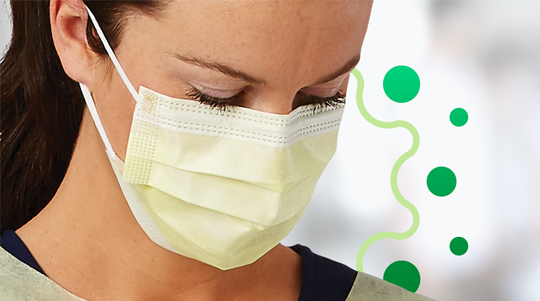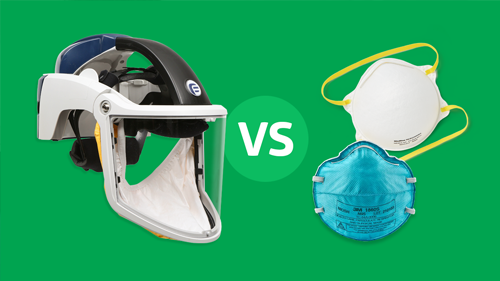LTCF PPE requirements: How to optimize usage and resources
Are you partnering with your PPE supplier?

You’re working every day to build a strong team defense in the fight against healthcare-associated infections (HAIs). How do you determine weaknesses? To help identify gaps in infection control practices, Medline completed “discovery assessments” with more than 100 long-term care providers across the nation in late 2022.
The goal being, once you assess your risk level, you’re better informed and armed to close those gaps through education, training and other viable solutions.
This article is the fourth in a five-part series on how to address each of the main infection control challenges identified.
So what did the assessment results show? We asked LTC leaders if they agreed with a study that said most healthcare workers don’t properly wear personal protective equipment (PPE). Here’s what we learned:

Our article “Enhanced Barrier Precautions: 6 tips for implementing in LTCFs,” based on recommendations by the Centers for Disease Control and Prevention (CDC)2, provides an overview of the PPE that staff should wear for everyone’s safety—and how to encourage them to wear it.
In this article, you’ll find 6 ways to partner with your medical supplier to boost PPE adherence.
Conduct a comprehensive PPE assessment
You need to identify gaps before you can close them. Your medical supplier can work with you to:
- Evaluate compliance with current FDA and CDC guidelines
- Conduct observational walk-throughs of each unit
- Identify areas of improvement
- Share insights and recommend a plan tailored to your facility’s specific needs
These steps will help ensure your team has the appropriate protection for every task.
Ensure reliable and timely supply
Many long-term care facilities (LTCFs) face limitations in terms of availability and accessibility of PPE. Shortages can be due to supply chain disruptions, inadequate funding or inadequate storage facilities. When staff don’t consistently have access to the right type and quantity of PPE, lapses in usage may occur.
Your supplier can help mitigate shortages and ensure your facility has the necessary PPE to comply with infection prevention protocols. This includes a wide range of PPE, such as face masks, gloves, medical gowns and other protective equipment.
“There are no hard and fast rules on what you have to have, so we’re working with customers to create those new standards,” says Evan Sabal, Medline Product Manager, Preventive Care. “You should have a stockpile to be ready for future events such as flu outbreaks.”
It’s important to understand your facility’s utilization rate by using the CDC’s PPE burn rate calculator3 or your medical supplier’s PPE stockpile calculator.
CMS surveyors look at specific uses of PPE in your facility. When staff are educated and trained consistently, everyone is safer and F880 tags can be avoided.

Evan Sabal
Medline Product Manager, Preventive Care
Assist with product selection and guidance
Perhaps you’re unsure of what products you need. Your medical supplier can help you select appropriate equipment such as N95 masks, surgical masks and isolation gowns—as well as explain their recommended usage in various situations. You’ll also learn product specifications, certifications and performance characteristics to help you make informed decisions.
Provide education and training
Your staff need to understand how and when to use PPE, including how to properly fit and adjust the gear. Your supplier can provide guides, instructional videos, webinars and other materials that highlight best practices for donning, doffing and disposing of PPE. In addition, you can collaborate on research and in-person training sessions to educate staff on the correct use of PPE.
“CMS surveyors look at specific uses of PPE in your facility,” says Sabal. “When staff are educated and trained consistently, everyone is safer and F880 tags can be avoided.”
Customize solutions for your facility
When you partner with your supplier, you can create customized solutions tailored to your facility’s specific challenges and needs. For example, you can work together to develop and implement clear, comprehensive standard operating procedures (SOPs). You also can collaborate on crafting signage and visual cues, and making other tools and resources available to help improve PPE compliance.
Provide technical support
You can turn to your supplier for troubleshooting and addressing any concerns or questions related to PPE. You’ll also benefit from customer service support to help manage your PPE inventory, track orders and ensure timely delivery.
Key takeaway
Staff in LTCFs often don’t wear the right PPE. You can improve adherence by implementing Enhanced Barrier Precautions. When you partner with your medical supplier on PPE gap assessment, supply accessibility, product selection, education and training, and customized solutions, staff have what they need to wear the right PPE every time. Stay tuned for the final installment of this article series.
References:
- Medline 2022 Long-Term Care Discovery Assessment Findings. Data on file.
- CDC. Frequently Asked Questions (FAQs) about Enhanced Barrier Precautions in Nursing Homes. Retrieved April 27, 2023, from https://www.cdc.gov/hai/containment/faqs.html
- CDC. Personal Protective Equipment (PPE) Burn Rate Calculator. Retrieved April 27, 2023, from Personal Protective Equipment (PPE) Burn Rate Calculator | CDC





